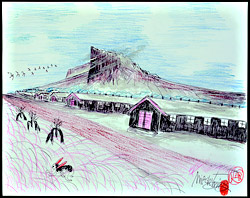One person can make a difference. Or one film. Linda Hattendorf’s earnest, affecting, lo-fi documentary flatters every viewer into thinking, “If only I stopped to take an interest in that bum, instead of just dropping some change in his cup, maybe I could get him off the street.” The wonder is that it worked for Hattendorf, who was already befriending and videotaping homeless octogenarian street artist Tsutomu “Jimmy” Mirikitani before 9/11. When the planes strike a few blocks south of Houston Street, incredibly, he keeps sketching and she keeps filming. More improbably still, when her SoHo block is choked with the toxic dust from the World Trade Center, she shelters the old coot in her tiny apartment—which in the coming months he takes over as his studio, charming her cat and criticizing her cooking. Fortunately, she keeps rolling tape, and her queries to the government (and Jimmy’s relatives in San Fran and Seattle) yield a poignant, remarkable life story. Born in Sacramento and raised in Hiroshima until 1938, Jimmy obsessively sketches the California internment camp where he was imprisoned during World War II. His colorful rubbed-pencil landscapes, dragons, and cats seem almost decorative, but they also mask his rage at his old jailers. “Crooked government!” he fumes, refusing to apply for Social Security, even as he (understandably) gets on Hattendorf’s nerves. Their Odd Couple dynamic outweighs her Chomsky-ish interpolation of the TV news (yes, we understand how Muslims are being unfairly scapegoated like the Japanese before), but neither the politics nor the storytelling limitations can dull your impression of Jimmy. Or the shameful sense that there are other stories out there like his—sleeping on park benches in the rain, still waiting to be noticed or filmed.
The Cats of Mirikitani
Unlawful detainee finally gets justice, six decades later.








